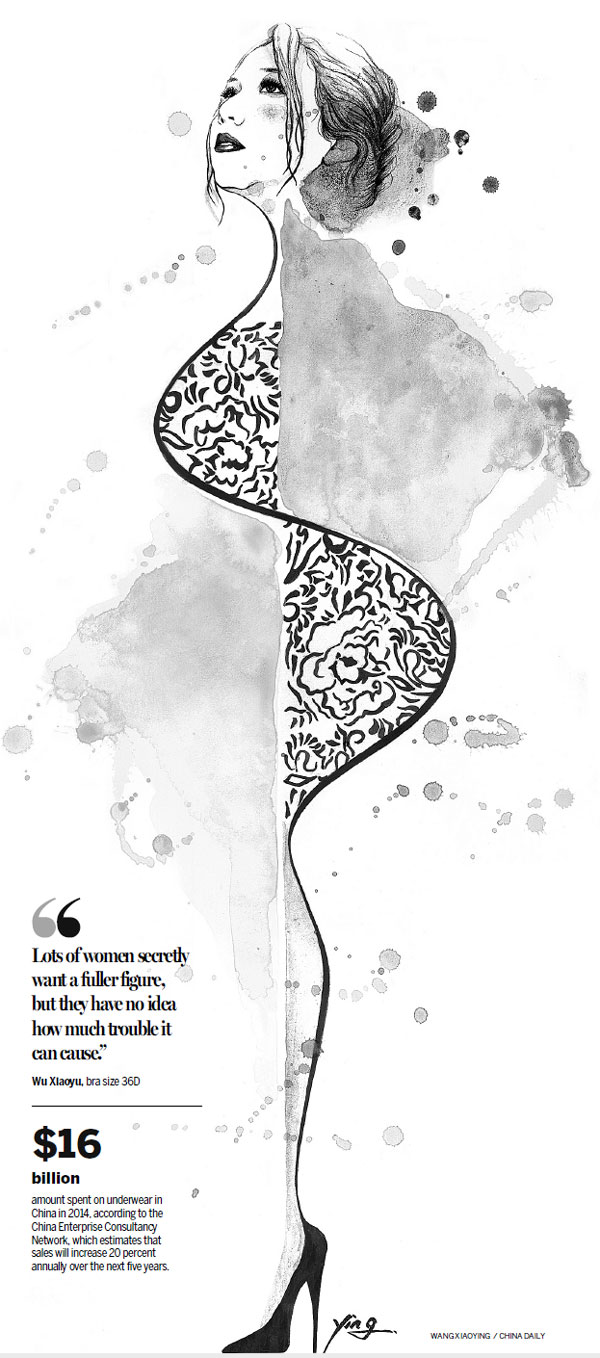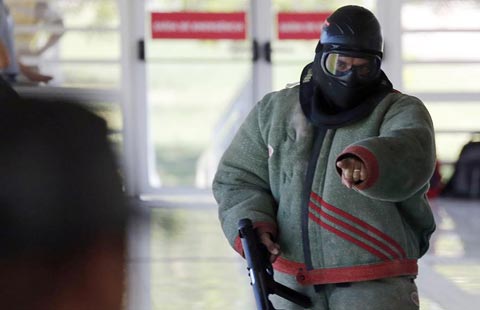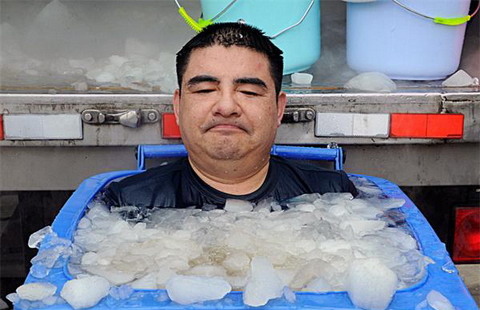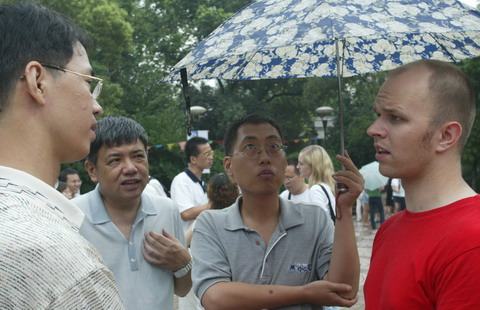
Chinese women are becoming fuller of figure thanks to a combination of social, physical and dietary changes that are overturning 'traditional' notions of national body types and may prompt a revolution in the lingerie industry. Yang Wanli reports.
There is a long-established stereotype of Asian, especially Chinese, women. They are seen as caring, polite and gentle, usually heavily family oriented, soft-spoken and with a gentle demeanor that conveys great charm. Physically, they are usually described as fragile, dainty and slender with small breasts, a notion underlined by a map widely circulated by Google in 2012 that showed the average cup size for bras was A.
A quarter of a century ago, Wu Xiaoyu would have been the exception that proved the rule in China. Her breasts didn't stop growing until she was 22, by which time her bra size was 36D, far larger than those of any of her friends or former classmates.
"At the very beginning I was so proud. Other girls were jealous of me. Every time they discussed bras, especially the ones that can make the breasts look bigger, I just said, 'I really need a flimsy cotton bra'," the 30-year-old said.
Great expectations, limited options
But Wu's quiet pride was soon knocked by a series of embarrassing incidents and the discovery that her choice of bras was extremely limited, and those that were available did little to enhance her feelings of femininity. "Bras with big cups, like mine, are rare in China. Even if you can find the perfect fit, there only a few colors or styles, usually no more than three," she said. "I have to buy them all because they're my only options, but nowadays women expect more from their underwear than just a comfortable fit."
Wu was also frustrated when she wore low-cut V-neck tops because passing men leered and made suggestive remarks. "Sometimes, I could see a filthy smile hovering on their lips, which always killed my happy mood," she said.
She said her cousin, who has an equally full figure, has also been subjected to crude remarks, and even worse treatment. "My aunt thought my cousin was too physically mature for her age, and forced her to bind her breasts, which she did until she left home and went to college. It's hard to believe something like that could happen in modern society," Wu said.
In 2007, Wu graduated and moved to the United Kingdom. She was surprised to discover that her new home was, in her own words, "a wonderland" for busty women.
She said the range of bra sizes, from AA to E, or even larger, was much wider than in China, and the choice of styles and colors was also far more varied. "More important, I could walk along the street confident that no one would stare or shout at me, even if I was wearing a low-cut V-neck," she said.
In early 2014, Wu returned to China and had her first baby. Amid the joy, though, another problem arose. During pregnancy, the body produces the sex hormone estrogen, which helps to determine breast growth. Wu's breasts swelled until her cup size became an E, making it almost impossible for her to find a suitable bra in the domestic market. Although she considered buying bras on the Internet, she was wary of doing so because different companies use different sizing scales and each brand has its own design quirks that can render the bras uncomfortable or ill fitting and may result in back pain and other physical problems.
"I plan to stay and work in China, but I have a problem finding underwear suitable for a smart office environment. Lots of women secretly want a fuller figure, but they have no idea how much trouble it can cause," Wu said.
Shifting shapes
Decades ago, Wu's figure would have been unusual for a Chinese woman, but the situation has changed in recent years. In a recent interview with Vista Magazine, Yu Xiaodan, who has worked as a designer for such companies as Maidenform, Elle and Vera Wang Princess, said breasts are getting bigger worldwide.
Breast size, which is typically quoted in bra size, is determined by subtracting the band measurement from the cup measurement. Each inch represents a cup size, which is expressed in letters, The range begins at A (or AA in some countries), so a difference of 1 inch represents an A cup, while 3 inches represents a C cup. Differences greater than 4 inches are typically expressed in factors of D.
Yu said that when she began working as a designer 10 years ago, the average bra size in the UK was 34B, but it has now jumped to 36D. In the 1930s, US bra-sizing charts ranged from A to D, but now cover AA to F and even G. Larger sizes, such as J and K, can be found in some shopping malls, she added.
According to the website LiveScience, by 2013 the average breast size in the US had risen to 36C from 34B in 1995, and a survey conducted by the lingerie retailer Intimacy indicated that the average bra size in the US has jumped to 34E from 34B in the past 20 years.
China hasn't been immune to the global changes. The latest statistics from the China Physical Fitness Surveillance Center used a data comparison of the years 2000 and 2010, which showed that Chinese women had grown taller and their breasts had become fuller, despite no obvious weight increase during the decade.
Among women age 20 to 24, average breast size rose from 81.5 centimeters in 2000 to 82 in 2010, and height increased from 158.6 cm to 159. For the 25 to 29 age group, breast size rose to 83.4 cm in 2010 from 82.5 in 2000, and height increased to 158.7 cm from 158.2.
"The sizing charts for dressmakers in China have changed in tandem with developments across the world. The screening samples we've collected indicate that the proportion of B and C cups has risen," said Zheng Rong, a leading researcher at the Aimer Human Engineering Research Center at the Beijing Institute of Fashion Technology.
The center, launched in 2009 by the Chinese lingerie manufacturer Aimer, holds more than 8,000 samples of Chinese body types collected from people age 7 to 70. More than 70 percent of the examples are in the 18 to 50 age group, and women account for 80 percent of all samples.
Zheng said that in the 1990s, the most common bra sizes in China were 34A and 34B. "Now it's 34B and 34C. But only a few lingerie companies in China have invested in production and design facilities for larger sizes, such as 34D, because there are still so few customers, compared with Western countries," she said.
DNA and diet
Breast size is primarily determined by genetics, but diet and other factors, such as rising standards of living, also play decisive roles.
"Breasts are mostly made up of fatty material, so significant weight loss may reduce the size of the breasts in proportion to overall weight loss. However, the rising rate of obesity has played a part in the increase in breast size," said Liu Miao, a physician in the breast surgery department at Peking University People's Hospital.
"Because our daily diet contains more fat than 30 or 40 years ago, we've seen a corresponding rise in obesity in the past few decades. So the growth in women's measurements isn't all that surprising," she said.
Chen Xi, a member of the Association of Chinese Dietitians, said a rise in estrogen intake may also be behind the changes. "Teens today are exposed to estrogenic chemicals in their diets, and girls are reaching puberty earlier than ever before," he said. "In addition, the younger generation is having fewer children, so women are breastfeeding for a much shorter period, which has also contributed to the change in size."
He said most "breast-enhancing" oral medicines on the market contain ingredients such as fennel seeds and fenugreek, which nutritionists believe to have estrogenic properties. Meanwhile, the development of plastic surgery means it's now easier for women who feel their breasts are too small to opt for augmentation surgery.
"This sort of surgery is now one of the most commonly performed cosmetic procedures in the United States," he said.
Data developments
Modern design technology is also being used more widely in the clothing industry, and 3-D screening techniques and other developments are providing far more accurate data about body types.
"Current motion-capture technology collects the data very precisely. That means we can make certain items, such as sports dresses and lingerie, more comfortable to wear," Aimer's Zheng said. "But in the future, as demand rises and the underwear industry develops, an even greater range of options will be available in the domestic market."
According to the China Enterprises Consultancy Network, underwear sales in China hit more than 100 billion yuan ($16 billion) last year, and it's estimated they will soar by 20 percent annually for the next five years. This year alone, the value may rise to 500 billion yuan.
"People will expect far more, and their expectations of function and design will be become more refined. Some women prefer pushup bras, while others may choose thin, comfortable ones. The underwear industry will focus on wider sizing charts, and there will be a greater choice of both luxury and regular products," said Zhang Hongyu, Aimer's design director.
Zhang said women born after 1970 have a different perception of lingerie: "Compared with previous generations, they pay more attention to a healthy figure and they want to show off their curves using comfortable products, such as 'Shapewear', where the fabric helps to mold the curves, not hard bones."
She said Chinese women traditionally chose heavily padded bras, but change is inevitable as the influence of Western culture grows. "During our company's interviews with models, I discovered that women from Western countries showed more confidence and willingness to wear non-padded bras," Zhang said. "I believe that in time a lot more Chinese women will also begin to appreciate the natural beauty of their bodies, and a turning point like that will bring about a revolution in the country's underwear industry."
Contact the writer at yangwanli@chinadaily.com.cn

(China Daily 03/26/2015 page5)








